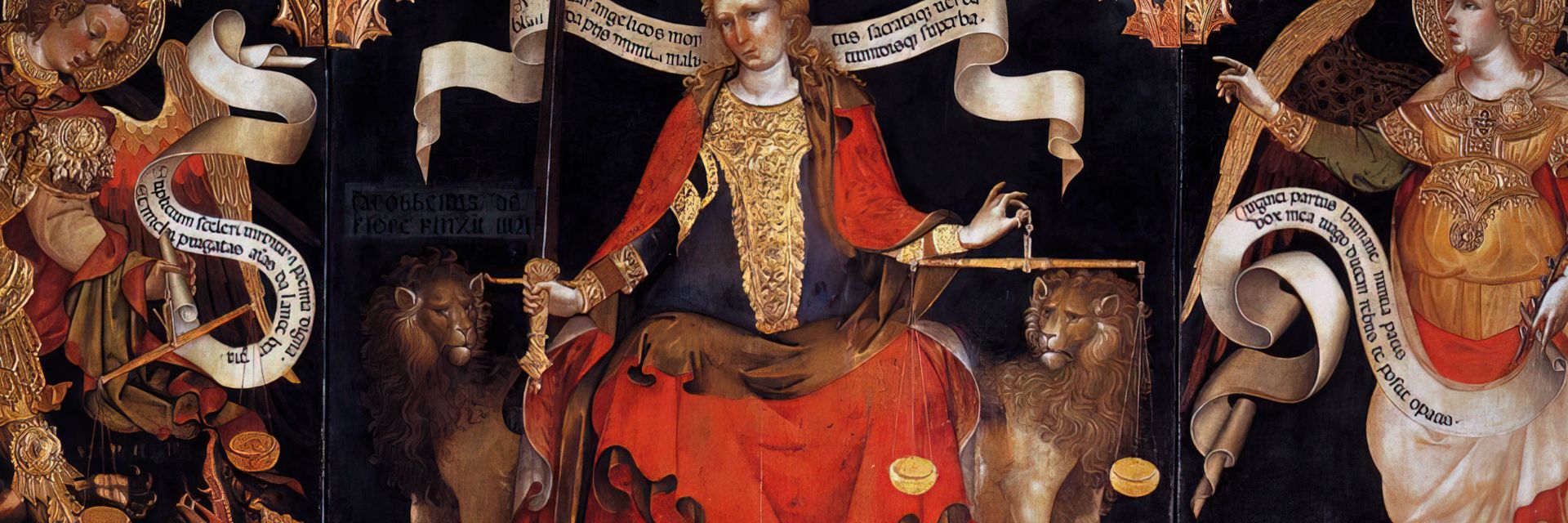Images of justice abound, from the ancient Egyptians to present-day courthouses. How do such images reflect our beliefs about judgment, reward, and punishment?
◊
Justice is everywhere – or, at least, icons abound – at the United States Supreme Court building. For example, in and around “The Marble Palace,” Justice is carved into friezes and appears as statues. She is blindfolded in some images, often holding a sword in one hand and a scale in another. These artworks are just a handful of many such images in courthouses across the United States. Similar images are common around the world wherever justice is meted out.

.jpg)
.jpg) “Contemplation of Justice” outside the U.S. Supreme Court
“Contemplation of Justice” outside the U.S. Supreme Court
(Source: Wikimedia Commons)
Most of us have grown up with Lady Justice, secure in our belief of what the image represents: impartial justice without fear or favor. Our ideal is that judgments are guided by the bedrock principle that we are equal under the law. But does this belief actually align with these iconic representations and, more importantly, does our system of justice really work? A fascinating history helps us think about how we could understand the answers.
Justice as Judgment
For many, justice is based upon religious belief. In the Abrahamic traditions, for example, Judgment Day (or The Last Judgment) reflects the belief that, at the end of the world, God will consign the wicked to eternal damnation in Hell and welcome the blessed to Heaven. The judgment is just – after all, no less than the Creator deems who in the entire history of humankind is to be punished or rewarded.
Images of justice as a sort of judgment are common within and outside of the Abrahamic traditions. For example, ancient Egyptians created the Book of the Dead as instructions to aid the deceased toward the afterlife. One scene depicts Anubis, son of Osiris, leading Hunefer to judgment. The jackal-headed deity, who accompanied kings into the afterlife, placed the deceased’s heart on one side of a scale and a feather on the other. The results determined whether or not the king would enter the afterlife.
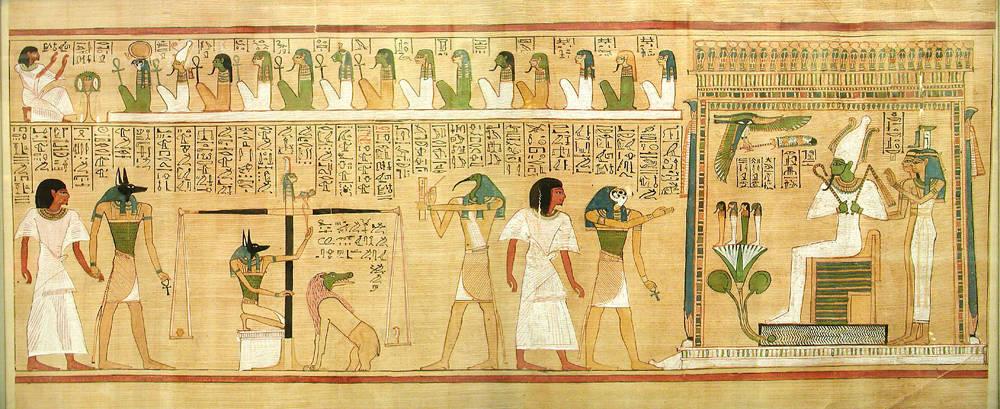
A drawing of the last judgment of Hunefer, from The Book of the Dead. (Source: Wikimedia Commons)
Among the fascinating features of the ancient Egyptian beliefs about judgment is that the feather placed on the scale comes from Ma’at (pronounced may-et). Signifying an ethical or orderly life, the feather is associated with an Egyptian goddess, which is early evidence of connections between justice and women.
For more on historical depictions of judgment and justice, check out the MagellanTV series Judgment Day: Images of Heaven and Hell.
Justice is a Woman
As Ma’at shows us, images of justice as a woman date back at least to 4000 BCE. Said to have been born at the beginning of creation, through the power of magic personified in Heka, Ma’at came into being when the sun god, Ra, arose from the waters of Nun. “Ma’at” means “that which is straight,” which suggests clear-sightedness, truth, justice, harmony, and balance. Thought to have married Thoth, the Egyptian god of wisdom, Ma’at’s nature imbued the world with rational purposiveness. To live a good life – and to achieve peace in the afterlife – is to live according to Ma’at. It’s not surprising, then, that the quality of a person’s life is judged according to a conception of justice as ordered and balanced – or, if you will, weighed against something as light as a feather.
Around 700 BCE, the ancient Greek goddess Themis was believed to preside over justice and law. Her name stemmed from the Greek for “order,” “law,” or “custom,” and her purview as a goddess included wisdom, good counsel, and interpretation of what the Greek gods wanted of us. The daughter of Uranus (sky) and Gaia (earth), Themis generated divine law, presided over gatherings, and instructed humans in justice and morality. The daughter of Zeus and Themis was the goddess of justice, Dike. Dike is described in ancient texts as holding a staff (stick) and balance (a version of a scale). Closely associated with Dike, though not related, is Astrea, the goddess of justice, purity, and innocence.
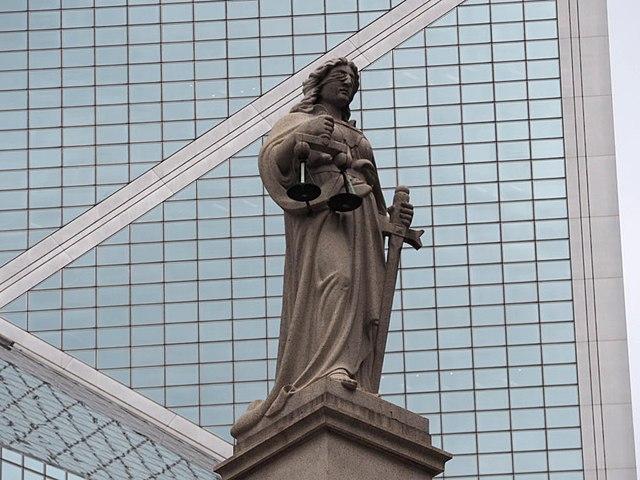
Themis statue holding the Scales of Justice and a sword in front of the Hong Kong Court of Final Appeal Building (Old Supreme Court) with the Bank of China tower behind. (Source: Wikimedia Commons)
From the early Roman tradition, which adopted and adapted many Greek divinities, comes the goddess Justitia. Having lived among humans, Justitia is said to have fled because of their moral transgressions. Our images of Justice are combinations of these divine figures, though it’s not entirely clear why women are associated with the very values from which they were historically excluded in patriarchal societies, such as participating in political life.
Ancient Greek men typically did not think of women existing outside the home. Athenian women, for example, were not citizens and could not own property or participate in civic life. Spartan women, on the other hand, fared a bit better – they were permitted to drink wine and own property.
Think about it this way: Until the Equal Credit Opportunity Act was passed in late 1974, women in the United States did not have the legal right to credit in their own names. Instead, they were typically required to have a male co-signer. Through a good chunk of the 20th century, most U.S. states considered women “unfit” to serve on juries simply because they were women. As such, they were considered the “defective sex.” It wasn’t until the Civil Rights Act of 1957 that women were granted the right to serve on federal juries, and it wasn’t until 1975 that the U.S. Supreme Court held that states could not deny women the right to serve on juries (though by 1973, all 50 states had passed such legislation).
The issue was not unique to the United States, of course. In fact, there are still plenty of inequalities around the globe. According to the World Bank, for example, approximately “2.5 billion women of working age are not afforded equal economic opportunity and 178 countries maintain legal barriers that prevent their full economic participation.”
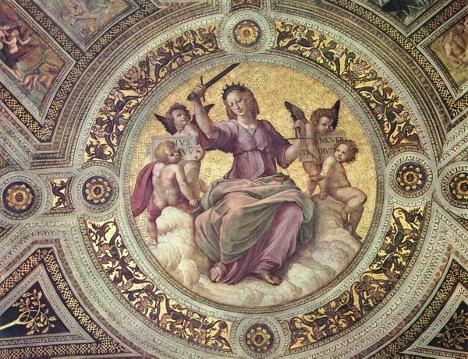
Raphael’s Justitia. (Source: Wikimedia Commons)
One answer to the question of why our iconic images of justice are women is that the foundation of U.S. law is English common law, which, in turn, is based on the Roman system that personified justice in the form of the goddess Justitia. So, we could simply say we inherited the image of justice as a woman from an ancient tradition and be done with it. But that seems at least somewhat unsatisfying. After all, the image is clearly inconsistent with the global history of excluding women. It seems only, well, just to point out the inconsistency and to demand some sort of accounting, both from ourselves and each other – an accounting that genuinely grapples with a history of grave injustices that continue in one form or another today.
Consistency among beliefs, words, and actions are fundamental to most moral theories, and it is morality that underpins much of modern legal systems. More specifically, the concept of justice itself is part of a larger theory of morality, which I will discuss shortly. For the moment, let’s assume that we expect a justice system to live up to standards embodied in the iconic image of Lady Justice.
Justice’s Scales, Sword, and Blindfold
Contemporary and ancient images alike show Justice holding balancing scales. It’s one thing to weigh an object, for example, on a single scale. To compare that weight with another object draws our attention to a relationship. The nature of this relationship is what the scales of justice represent. For example, we can think about the relationship between one individual’s rights and those of another. And we can think about the relationship between one group’s and society’s needs.
In the Egyptian tradition, Ma’at held the feather of truth, but this is not portrayed in later versions. The feather was weighed against a dead person’s soul in the afterlife, but was essentially internalized later by faith in reason as the determiner of the facts of a case. The scales themselves are machines and, as such, they are objective measuring tools.
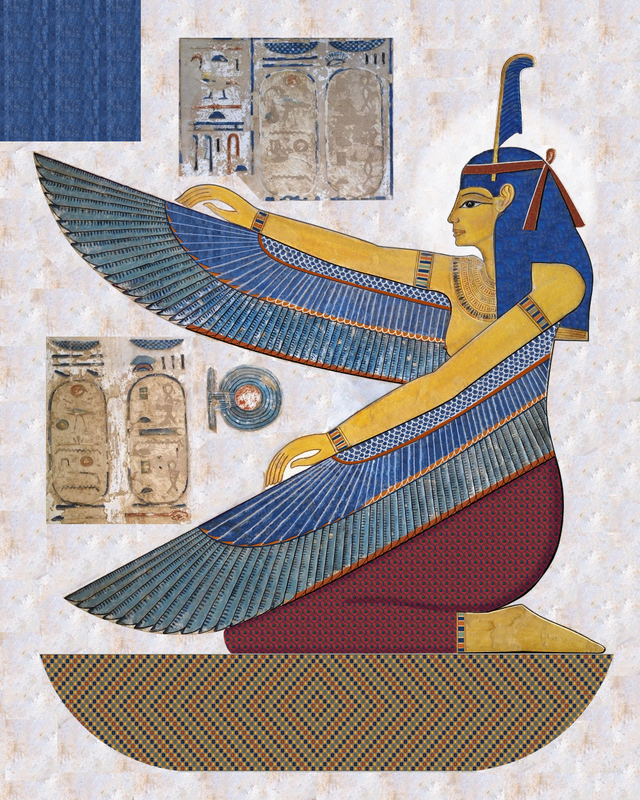
Goddess Ma’at (or Maat) of ancient Egypt – partly restored and partly re-constructed image of a wall-painting. (Source: Wikimedia Commons)
From Ma’at to the present day, Justice is often depicted as holding a sword. It is typically double-edged and represents the sort of authority one might be forced to recognize, if one is not already inclined to respect Justice’s other accessories. The sword protects and punishes, which is how it derives its power. And, though it is a powerful tool, it is not arbitrary. In other words, Justice does not favor either party that comes before her.
The ancient goddesses were not depicted wearing blindfolds, and many contemporary renderings of Justice show her without one. The blindfold symbolizes the idea that a just legal system is impartial. The scales measure and the sword protects (in some cases by punishing). Without impartiality, however, they can do great harm.
Similarly, the lack of a blindfold can be explained in terms of Justice keeping both eyes on the process to ensure there are no errors. After all, if both scales and sword are mere tools, they can be used well or poorly.
Justice Is a Moral Concept
To be concerned about justice is to exhibit care. Perhaps this is why the concept of justice is personified as a woman. Whether reviled or revered for it, patriarchal societies have historically associated women with caring. To care is, among other things, to pay specific and diligent attention. Justice demands care. Without it, disorder, inequality, and suffering become normal. Indeed, for many, these characterizations accurately describe life today.
The image of justice reveals further significant concepts that are important to our moral lives. These include fairness, objectivity, and truth. We value fairness because we believe that no one is better than anyone else – ethnicity, where you were born or raised, or your social or economic status do not make you more or less important as a human being than anyone else. We value objectivity because we believe right and wrong are not matters of mere opinion, which can vary from person to person, but instead are independent of our individual feelings and beliefs. In fact, we associate objectivity with truth, as when we say that the answer to a math question is true or false, regardless of what you or I happen to believe or feel about it.
The Code of Ur-Nammu is the earliest surviving law code – it predates Hammurabi’s code by about 300 years. Written either by Sumerian king, Ur-Nammu, or Shulgi of Ur, his son, the Mesopotamian code details punishments for crimes like murder, theft, and adultery.
Ultimately, these concepts are important to our beliefs that getting things right matters and that treating each other and ourselves in ways that reflect the truth is worthwhile. Perhaps the most important moral concept that underlies justice, then, is that no one human being is more valuable than any other. We believe, ultimately, that we ought to conduct ourselves and relate to others in specific ways precisely because, as human beings, we are equally valuable. When that moral worth is violated, we are understandably upset – and we should be, regardless of who has been harmed.
The interpretations of the image of Justice ultimately raise more questions than they answer. For example, what is the point of punishment? What is the truth that the justice process is meant to establish? Who decides what the needs of society are? These and other questions are worth contemplating, and the answers largely determine how just, in fact, societies actually are.
Ω
Mia Wood is a professor of philosophy at Pierce College in Woodland Hills, California, a visiting lecturer at the Community College of Rhode Island, and an adjunct instructor at the University of Rhode Island and Providence College. She is also a freelance writer interested in the intersection of philosophy and everything else. She lives in Little Compton, Rhode Island.
Title image: Jacob del Fiore’s “Justice between the Archangels Michael and Gabriel” (Source: Wikimedia Commons)
